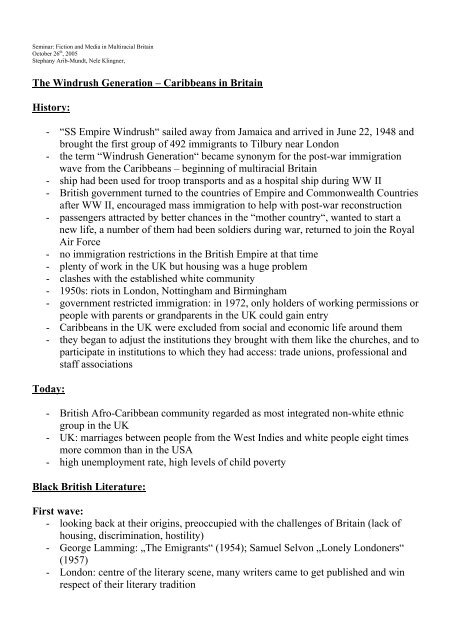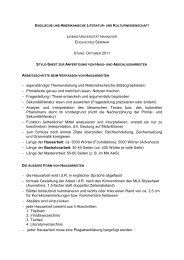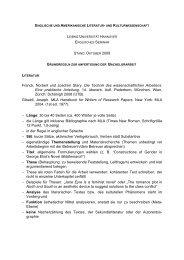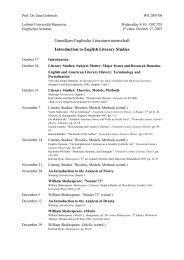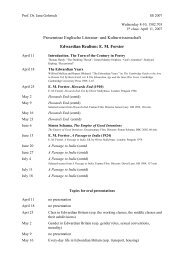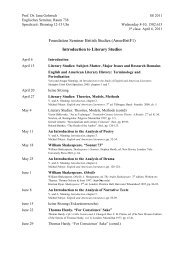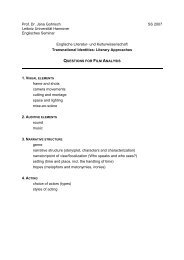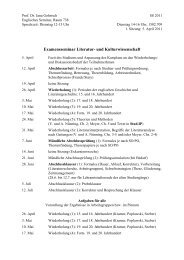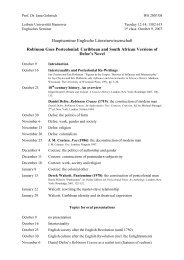The Windrush Generation - Caribbeans in Britain (Handout)
The Windrush Generation - Caribbeans in Britain (Handout)
The Windrush Generation - Caribbeans in Britain (Handout)
Create successful ePaper yourself
Turn your PDF publications into a flip-book with our unique Google optimized e-Paper software.
Sem<strong>in</strong>ar: Fiction and Media <strong>in</strong> Multiracial Brita<strong>in</strong><br />
October 26 th , 2005<br />
Stephany Arib-Mundt, Nele Kl<strong>in</strong>gner,<br />
<strong>The</strong> <strong>W<strong>in</strong>drush</strong> <strong>Generation</strong> – <strong>Caribbeans</strong> <strong>in</strong> Brita<strong>in</strong><br />
History:<br />
- “SS Empire <strong>W<strong>in</strong>drush</strong>“ sailed away from Jamaica and arrived <strong>in</strong> June 22, 1948 and<br />
brought the first group of 492 immigrants to Tilbury near London<br />
- the term “<strong>W<strong>in</strong>drush</strong> <strong>Generation</strong>“ became synonym for the post-war immigration<br />
wave from the <strong>Caribbeans</strong> – beg<strong>in</strong>n<strong>in</strong>g of multiracial Brita<strong>in</strong><br />
- ship had been used for troop transports and as a hospital ship dur<strong>in</strong>g WW II<br />
- British government turned to the countries of Empire and Commonwealth Countries<br />
after WW II, encouraged mass immigration to help with post-war reconstruction<br />
- passengers attracted by better chances <strong>in</strong> the “mother country“, wanted to start a<br />
new life, a number of them had been soldiers dur<strong>in</strong>g war, returned to jo<strong>in</strong> the Royal<br />
Air Force<br />
- no immigration restrictions <strong>in</strong> the British Empire at that time<br />
- plenty of work <strong>in</strong> the UK but hous<strong>in</strong>g was a huge problem<br />
- clashes with the established white community<br />
- 1950s: riots <strong>in</strong> London, Nott<strong>in</strong>gham and Birm<strong>in</strong>gham<br />
- government restricted immigration: <strong>in</strong> 1972, only holders of work<strong>in</strong>g permissions or<br />
people with parents or grandparents <strong>in</strong> the UK could ga<strong>in</strong> entry<br />
- <strong>Caribbeans</strong> <strong>in</strong> the UK were excluded from social and economic life around them<br />
- they began to adjust the <strong>in</strong>stitutions they brought with them like the churches, and to<br />
participate <strong>in</strong> <strong>in</strong>stitutions to which they had access: trade unions, professional and<br />
staff associations<br />
Today:<br />
- British Afro-Caribbean community regarded as most <strong>in</strong>tegrated non-white ethnic<br />
group <strong>in</strong> the UK<br />
- UK: marriages between people from the West Indies and white people eight times<br />
more common than <strong>in</strong> the USA<br />
- high unemployment rate, high levels of child poverty<br />
Black British Literature:<br />
First wave:<br />
- look<strong>in</strong>g back at their orig<strong>in</strong>s, preoccupied with the challenges of Brita<strong>in</strong> (lack of<br />
hous<strong>in</strong>g, discrim<strong>in</strong>ation, hostility)<br />
- George Lamm<strong>in</strong>g: „<strong>The</strong> Emigrants“ (1954); Samuel Selvon „Lonely Londoners“<br />
(1957)<br />
- London: centre of the literary scene, many writers came to get published and w<strong>in</strong><br />
respect of their literary tradition
- no direct personal <strong>in</strong>volvement <strong>in</strong> political movements (they wrote poetry and<br />
fiction, not political tracts)<br />
- many <strong>in</strong>tellectuals attracted by the economic opportunities of post-war Brita<strong>in</strong>.<br />
- „familiar strangers“: they knew British culture, landscape and manners. <strong>The</strong>ir<br />
imag<strong>in</strong>ation of the country was dom<strong>in</strong>ated by the works of Shakespeare, Blake,<br />
Dickens or Austen<br />
- Samuel Selvon <strong>in</strong> „F<strong>in</strong>d<strong>in</strong>g West Indian Identity <strong>in</strong> London“: „<strong>The</strong>re was also a<br />
feel<strong>in</strong>g for the English Countryside and landscape which had possessed me from<br />
schoolday read<strong>in</strong>g of English poets. In the hot tropical atmosphere I dreamed of<br />
green fields and roll<strong>in</strong>g downs, of purl<strong>in</strong>g streams and daffodils and tulips, thatched<br />
cottages and quiet pubs nestl<strong>in</strong>g <strong>in</strong> the valleys. And I wanted to see for myself the<br />
leafless trees covered with snow as depicted on Christmas postcards“.<br />
<strong>The</strong> 1960s:<br />
- 1958: Nott<strong>in</strong>g Hill Riots<br />
- Black British People began to look to the United States and the struggle for Civil<br />
rights<br />
- revolutionary and angry 1960s<br />
- „Paid Servant“ (1962) by Edward Ricardo Braithwhaite, frustrated by his work as a<br />
teacher and social worker<br />
- established writers revisit<strong>in</strong>g the Caribbean and the homelands of their ancestors,<br />
paid attention to their state of „exile“<br />
- Caribbean Arts Movement set up <strong>in</strong> 1966 by writers like Edward Kamau<br />
Brathwhaite or the publisher John La Rose. <strong>The</strong>y wanted to be promote new black<br />
literature by writers from the metropolitan centres + countries of orig<strong>in</strong><br />
- Caribbean Voices:<br />
o s<strong>in</strong>ce 1946, ma<strong>in</strong> platform for read<strong>in</strong>gs by West Indian writers and for<br />
discussion of their works<br />
o radio programme, 30 m<strong>in</strong>utes<br />
o helped to start the careers of George Lamm<strong>in</strong>g, Edward Kamau Brathwhaite,<br />
V.S. Naipaul or Samuel Selvon<br />
o was aimed at the West Indian audience <strong>in</strong> the West Indies - doubtful, whether<br />
it made any significant impact on promot<strong>in</strong>g Caribbean writ<strong>in</strong>g among a<br />
British readership<br />
o Newspapers and Magaz<strong>in</strong>es brought West Indian literature to the attention of<br />
the British<br />
<strong>The</strong> Angry New <strong>Generation</strong>:<br />
- born or grown up <strong>in</strong> Brita<strong>in</strong>, did not put up with the challenges of Brita<strong>in</strong> <strong>in</strong> the<br />
polite way their parents had done<br />
- L<strong>in</strong>ton Kwesi Johnson: expressed the frustrations about be<strong>in</strong>g born and brought up,<br />
but not accepted <strong>in</strong> Brita<strong>in</strong> through poetry and literature<br />
- 1976: another riot at the Nott<strong>in</strong>g Hill Carnival, watershed <strong>in</strong> the development of<br />
black British identity<br />
- a search backwards began, for example to Rastafarianism
- new music scene evolved<br />
- women writers: Buchi Emecheta wrote her autobiography „In the Ditch“ <strong>in</strong> 1972<br />
- „old“ writers like Lamm<strong>in</strong>g, E.R. Braithwhaite or Samuel Selvon left the country<br />
and began write from abroad (the <strong>Caribbeans</strong>, Canada or the USA)<br />
- the young generation, like Caryl Phillips („Strange Fruit“, 1982) found a way to<br />
express themselves through poetry and theatre<br />
- black British writers today look back to their sources but are much more confident<br />
about their own position <strong>in</strong> Brita<strong>in</strong><br />
- In the 1980s Brita<strong>in</strong> <strong>in</strong>stitutions opened up to black British people and supported<br />
black <strong>in</strong>stitutions and artists<br />
- Black Community writ<strong>in</strong>g groups: topics like gender and sexuality had been<br />
discussed - questions of identity and freedom are still important topics<br />
- today: broader varieties of genres and issues<br />
Black British (BB) film mak<strong>in</strong>g:<br />
- 1960s onwards black Britons began to make their own films and tv-productions,<br />
greater part of BB film productions produced s<strong>in</strong>ce mid-1970s<br />
- filmmak<strong>in</strong>g is a sector <strong>in</strong> BB culture whose importance has been <strong>in</strong>creas<strong>in</strong>gly<br />
recognised only s<strong>in</strong>ce the 1980s<br />
- most post-war Caribbean immigrants settled <strong>in</strong> urban areas (esp. London) →<br />
screen<strong>in</strong>g of the capital as they experienced it<br />
- treatment of London – the access permitted or denied to its space(s) – <strong>in</strong> Black<br />
British film reflects the grow<strong>in</strong>g cultural empowerment of black people <strong>in</strong> Brita<strong>in</strong><br />
- ma<strong>in</strong> features: mak<strong>in</strong>g ´ethnic London` visible; self-construction / creation of<br />
identity <strong>in</strong> host culture; suffered hardship (race-issue)<br />
- metropolitan desire (which had grown before their arrival <strong>in</strong> Brita<strong>in</strong>) faces great<br />
disappo<strong>in</strong>tment after arrival: not be<strong>in</strong>g welcome, denial of access to the metropolis,<br />
conf<strong>in</strong>ement <strong>in</strong> periphery<br />
→ c<strong>in</strong>ematic depictions of 1 st -generation migrants characterized by “characterless<br />
streets and derelict houses clear of charismatic London sites” (source: TABB article)<br />
→ reflection of dismal hous<strong>in</strong>g conditions the Caribbean immigrants had to face <strong>in</strong><br />
the 1950s and 1960s<br />
- furthermore: characters are often conf<strong>in</strong>ed to <strong>in</strong>door-locations → “<strong>in</strong>terior / exterior<br />
dichotomy as a special metaphor for social distance and isolation” (source: TABB<br />
article)<br />
- another approach to elaborate the migrants’ self-construction <strong>in</strong> the struggle<br />
between home and host culture often represented through 3 ma<strong>in</strong> features:<br />
o creat<strong>in</strong>g symbolic spaces (symbolic for the relevant culture)<br />
o us<strong>in</strong>g of ´double space` for the protagonist’s act of self-location<br />
o emphasis on physical travers<strong>in</strong>g of spaces (drift<strong>in</strong>g between spaces, journeys,<br />
searches)
Examples:<br />
- “Flame In <strong>The</strong> Streets” (UK 1961)<br />
o features mix of cultures: a white work<strong>in</strong>g-class family’s daughter<br />
falls <strong>in</strong> love with a Jamaican<br />
- landmark: “Pressure” (UK , 1975)<br />
o first BB film ever that was produced by black filmmakers and<br />
black director<br />
o racism evident but assimilation and progress evident (liv<strong>in</strong>g<br />
standards as middle-class shop-owners)<br />
o different attitudes between <strong>W<strong>in</strong>drush</strong> generation and post-<br />
<strong>W<strong>in</strong>drush</strong> generation: parents – hopes/ endeavour vs. children –<br />
disillusionment<br />
- “Burn<strong>in</strong>g An Illusion” (UK 1981)<br />
o highlights a hitherto unexplored world where nuances of black<br />
Britishness are brought up → black restaurant, pictures/<br />
photographs of black musicians and black celebrities<br />
o treats social changes not only as cultural but also as generational<br />
(1 st and 2 nd generation of immigrants)<br />
o total assimilation to British culture as the only way forward to<br />
young British blacks vs. first signs of self-consciousness/ black<br />
Britishness)<br />
- “<strong>The</strong> F<strong>in</strong>al Passage” (UK Channel Four , 1996)<br />
o Caryl Phillips’ 2-part-adaptation of his 1985 published novel<br />
o 1 st time a British tv-drama had focused on the experiences of<br />
<strong>W<strong>in</strong>drush</strong> generation s<strong>in</strong>ce John Elliot´s “A Man from the<br />
Sun”(UK , 1956)<br />
Sources:<br />
Blake, Anne, et al. (2001). England through Colonial Eyes <strong>in</strong> Twentieth-Century Fiction.<br />
New York: Palgrave.<br />
Bourne, Stephen (2001). Black <strong>in</strong> the British Frame. <strong>The</strong> Black Experience <strong>in</strong> British Film<br />
and Television. London: Cont<strong>in</strong>uum International Publish<strong>in</strong>g Group Academi<br />
Dennis, Ferd<strong>in</strong>and & Naseem Khan (eds.) (2000). Voices of the Cross<strong>in</strong>g: <strong>The</strong> impact of<br />
Brita<strong>in</strong> writers from Asia, the Caribbean and Africa. Serpent’s Tail: London.<br />
Wambu, Onyeachi (1998). Black British Literature s<strong>in</strong>ce <strong>W<strong>in</strong>drush</strong>.<br />
www.bbc.co.uk/history/society_culture/multicultural/literature_01.shtml (Oktober 19 th , 2005)<br />
Phillips, Mike (1998). <strong>W<strong>in</strong>drush</strong>. <strong>The</strong> Passengers.<br />
www.bbc.co.uk/history/society_culture/multicultural/w<strong>in</strong>drush_01.shtml (Oktober 19 th , 2005)<br />
www.uni-tueb<strong>in</strong>gen.de/tabb/articles/metropolis.html; (October 21 th, 2005)<br />
www.guardian.co.uk/arts/reviews/story/0,,1491330,00.html; (October 21 th, 2005)<br />
www.screenonl<strong>in</strong>e.org.uk/film/id/475471/; (October 21 th, 2005)<br />
www.screenonl<strong>in</strong>e.org.uk/film/id/480472/<strong>in</strong>dex.html; (October 21 th, 2005)<br />
www.bfi.org.uk/; (October 21 th, 2005)<br />
www.guardian.co.uk/arts/nott<strong>in</strong>ghillcarnival2002/story/0,12331,773465,00.html; (October 21 th, 2005)<br />
www.kamera.co.uk/reviews_extra/wondrous_oblivion.php; (October 21 th, 2005)<br />
www.channel4.com/film/reviews/film.jsp?id=130233; (October 21 th, 2005)<br />
www.wikipedia.org; (Oktober 19 th , 2005)<br />
www.bbc.co.uk/history; (Oktober 19 th , 2005)


